Sunday Dec 14, 2025
Sunday Dec 14, 2025
Thursday, 12 June 2025 01:23 - - {{hitsCtrl.values.hits}}
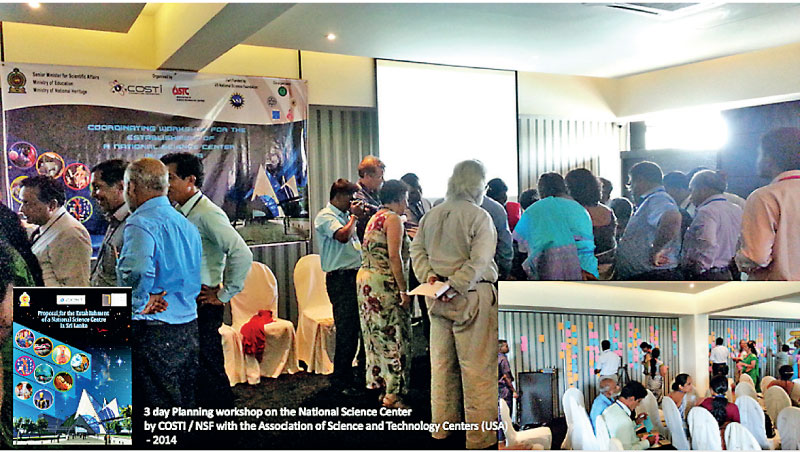
Three-day planning workshop on the National Science Centre by COSTI/NSF with the Association of Science and Technology Centers (USA) – 2014
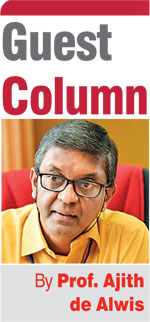 We live in a society shaped by the advances in science and technology. When we use solar power to generate electricity or hydrogen in today’s context, we do not worship and pray for the sun to perform the task – The Sun today is no Sun God! In all facets of our lives today S&T touches us though many may not know all the nuances of energy and material flows. To realise the best and also to ensure continued advances the general society should have science literacy. Science being so pervasive in living and in society has made it to be not only for the scientific community but for all members. Of course, the scientific community has an added responsibility as they lead in the advancement.
We live in a society shaped by the advances in science and technology. When we use solar power to generate electricity or hydrogen in today’s context, we do not worship and pray for the sun to perform the task – The Sun today is no Sun God! In all facets of our lives today S&T touches us though many may not know all the nuances of energy and material flows. To realise the best and also to ensure continued advances the general society should have science literacy. Science being so pervasive in living and in society has made it to be not only for the scientific community but for all members. Of course, the scientific community has an added responsibility as they lead in the advancement.
When there are decent levels of scientific literacy the societies are likely to have a positive science culture, excellent evidence based decision making, analytical mindsets, etc. The gaps in different societies are a manifestation of the differences in integrating these advances to the benefit of humanity. That fact that we do have really a big science literacy gap is evident when we listen to speeches of the day and read the plans and the thought process. Highly literate in one way but quite poor in science literacy. We allow weather gods to be responsible for our salt and discuss wiper blades of old used airplanes. We remove fertiliser and pesticides with one stroke of a pen and banned GMOs in a similar manner. Many are street smart in making use of the advances without having any respect for the sciences behind and that way mostly abuses than benefit from science for collective advancement.
Scientific illiteracy of a significant percentage of our population is quite evident – sad to state but that is the reality. Formal science education is weak and informal science education is almost non-existent. Addressing this urgently had been the call to decision-makers for quite some time. Even at one point when success was imminent political decision-making prevailed and the possibility was squashed. Education is the primary means of ensuring this development in the society. Today specifically STEM/STEAM education drives this necessity and STEAM education is a global movement. On this aspect as well, a lot had been discussed, parliamentary reports submitted, and multiple launches made yet no firm advancement on the ground.
Informal science education
Another important development necessary is in informal science education. Learning at your leisure, learning playfully, and exposure at a very young age are key attributes here. For this to materialise infrastructure again has to be available and possible only through enlightened decision making with right investments.
Consider the message stated as you enter Beijing’s Science and Technology Museum – “The Museum is a large-scale science popularisation infrastructure that implements the strategy of developing the country through science and education, the strategy of innovation-driven development to improve the scientific quality of the people”. A crystal-clear statement and standing in front of the message board my mind had multiple flashbacks to the past over the experiences that I had and how those episodes fizzled out to nothing. The question I pondered over was when are we going to get this type of thinking from our leadership. To be honest, there were a number of individuals and organisations who tried, gave their best, and sacrificed a lot in the process. Today our landscape is barren as far as that type of infrastructure is concerned. Whatever the museums we have they are almost relics with no significant informal education role played by them as a network connected and in synergy.
The current position in Beijing gave me another opportunity to visit the Museum in the Olympic Park of Beijing. This time I had more time at my disposal to stay within and really soak up the atmosphere. What you notice at all times is the presence of children with their parents and in China, the whole extended family may be present. The behaviour is quite different from what you see in Colombo with school children – who usually move in a single file at speed through the building. Of course, the Colombo National Museum does not offer any displays for engagement – the Exploratorium concept is absent. In Beijing, it is almost always engagement, actively and with excitement. It is a massive facility and you simply cannot explore it in a day making multiple visits mandatory.
The 102,000 sq. metres have five main thematic displays – Children’s Science Paradise, Glory of China, Exploration and Discovery, Sci-tech, and Life and Challenges and the Future. It has in addition four special effect theatres – Dome Theater, Giant Screen Theater, Motion Theater, and 4D Theater. Besides these, there are many laboratories, classrooms, a science report hall, a multi-function room, and a short-term exhibition hall for traveling exhibitions and special displays. A fantastic collection awaits the visitor and with the built-in power to change the life’s trajectory of a child.
Transformation of mindset
I am sure the exposure enables a transformation of mindset. When viewing and interacting with humanoid robots in the Challenges and the Future with AI, Robotics, and Intelligent manufacturing even the ‘old’ in me awakens to a new world. Imagine that with a 10-year-old. They will grow up embracing the new as part of themselves. They would not be Luddites or the typical trade unionist. I feel sad when you still witness our people still reaching for the horoscope instead of a telescope or the microscope. Sizeable media time chunks are given to discuss what’s in store for you based on imaginary planetary arrangements. We are still allowing Rahu to dominate our time management!
With 2028 looming ahead of us – more problematic than George Orwell’s 1984 to us perhaps – we still happily meander through life with ignorance and superstars. Basically, SMSing ourselves to nowhere. Starting with SLAAS (Sri Lanka Association for the Advancement of Science, also even before as CAAS), NSF (National Science Foundation), NASSL (National Academy of Sciences Sri Lanka), COSTI (Coordinating Secretariat for Science, Technology, and Innovation), NIFS (National Institute for Fundamental Studies) and NIA (National Innovation Agency) all championed Science and Technology Museum/Exploratorium and STEM/STEAM education. Meetings, documents and multi-media presentations have been many over the years. Even cabinet decisions and budgetary allocations have been made. What more one may ask are needed?!
I am reminded of the support given by China on this topic as well where the National Science Foundation (NSF) energetically pushed again for a National Science Center in 2018. The Chinese Association of Natural Science Museum (CANSM) agreed with UNESCO to “assist countries involved in the Belt and Road Initiative in their development or strengthening of science centers and science museums”. As there was a request for support by the Sri Lankan Government (by NSF), UNESCO decided to support the establishment of the National Science Center, Sri Lanka together with CANSM. CANSM in turn invited the China Science and Technology Museum (CSTM) to, lead in providing technical assistance to the establishment of the National Science Center, Sri Lanka in partnership with UNESCO.
Under the guidance of UNESCO and CANSM, and on the basis of the Proposal for the Establishment of the National Science Center; Sri Lanka, CSTM finalised the compilation of the Conceptual Design Scheme for the Permanent Exhibition of the National Science Center, Sri Lanka in 2018. I believe this is the first such task by an agency in China for UNESCO. The effort here was at no cost to Sri Lanka. Now many years have gone since 2018. The design nicely bound and well-presented did reach Sri Lanka and probably today lying inside a cupboard somewhere.
The country since 2018 had gone up in the economic level and also experienced crashing down into bankruptcy. Steadying the economy has to happen through science and technology as the central pillar with innovation as the key process. The education system must be activated formally as well as informally. There is hardly any time to lose as we have only postponed debt repayment. The appeal is we must get the concept again activated and we have many proposals and costings. Sri Lanka is the only country in the region for not having a science museum. Can we afford to move forward without this institution?
In China you walk into any research institute or university there is a display area showcasing material. Children do visit all institutes and they start early learning about the value of scientific endeavours. The strength of China today has been due to its scientific and technological endeavours facilitated by unwavering and focused decision-making.
Lack of informal science education means that even the scientific literate at times lack knowledge beyond their borders. Learning has been stymied by a core curriculum and examinations. Rote learning is not the key to analytical thinking. That too is a big issue as there is no broader appreciation of other areas. Again, the net result is the ineffectiveness of decisions.
This situation must be reversed and action is badly needed. In this sector definitely, there is no need to reinvent the wheel as so much has been said, designed, and made available. It does not matter what you know until you know what matters – meaning scientific literacy is one of the most important for Sri Lanka today. Hm, come to think of it, Sri Lanka has one of the best literacy rates as a nation – 92% plus!
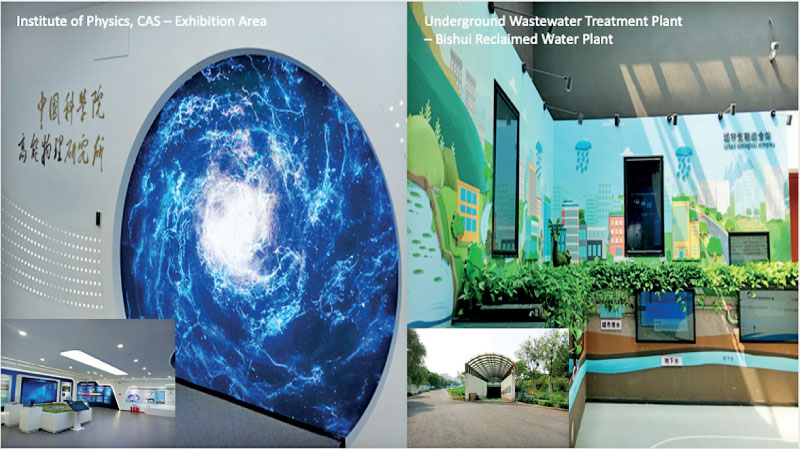
Institute of Physics, CAS – Exhibition area (left); and Underground wastewater treatment plant – Bishui Reclaimed Water Plant (right)
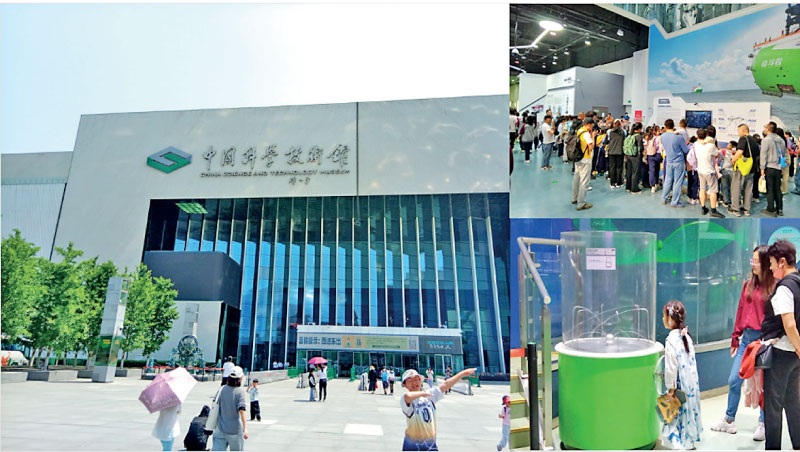
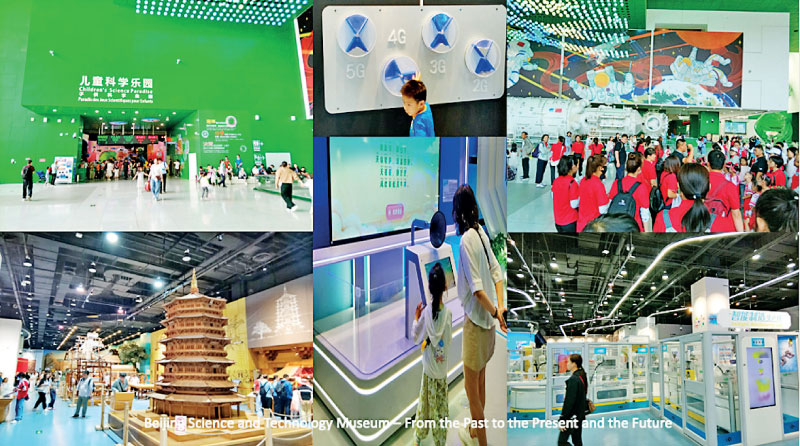
Beijing Science and Technology Museum – From the past to the present and the future